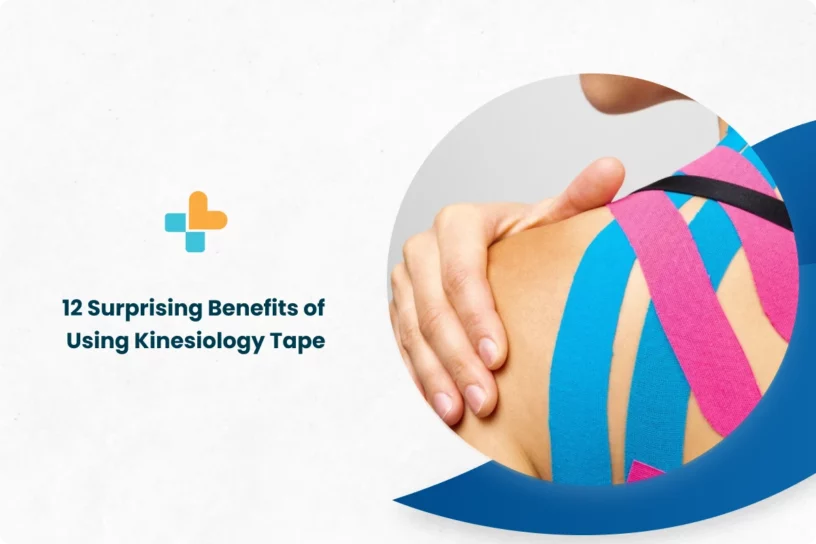What is Kinesiology Tape?
Kinesiology tape, also known as Kinesio tape or simply KT tape, is a type of elastic therapeutic tape that is applied to the skin to support muscles, reduce pain and inflammation, and improve mobility. It is often used in conjunction with physical therapy and athletic training to help alleviate pain. In this article, we will discuss the many benefits of kinesiology tape and the different ways it can be used to improve your health and well-being.
Benefits Of Kinesiology Tape
Reduces pain: Kinesiology tape reduces pain by using a technique called “mechanotransduction” where the tape’s stretch and compression properties stimulate the sensory receptors in the skin. This sends signals that can interrupt pain pathways and provide pain relief.
Reducing swelling and inflammation: The tape’s elasticity can help to reduce pressure on the affected area, which can further help to reduce inflammation and swelling.
Create Spaces in joints: Kinesiology tape can help to create spaces in joints by gently lifting the skin and creating more space for muscles and joints to move.
Improve blood and fluid circulation: Kinesiology tape can improve blood and fluid circulation by creating a decompression effect on the underlying tissues.
Stimulate Bruise and Contusion Recovery: By promoting blood flow and oxygenation, kinesiology tape can help to speed up the healing process and reduce the severity of bruises and contusions.
Prevent and relieve muscle spasms and Cramping: The tape’s elasticity allows it to stretch and move with the body, which can help to reduce muscle tension which in turn helps to prevent muscle spasms and cramping.
Support Injured Muscles: It supports injured muscles by providing compression, support, and stabilisation to the affected area, thereby allowing the muscles to heal faster and return to their normal function.
Accelerate muscle recovery: Kinesiology tape can help to accelerate muscle recovery by promoting blood flow to the affected area and reducing muscle tension.
Guarantee comfort: With its breathable and stretchy material, it can conform to the body’s shape and movement without causing irritation or discomfort. The tape is also water-resistant.
Reduce risk of injury: Kinesiology tape can help to prevent injuries by providing support to key muscle groups and helping to reduce the risk of strain and overuse.
Move freely: The tape is designed to allow for a full range of motion, it does not restrict movement or inhibit the natural movement of the muscle.
Improve muscle tone and strength: Kinesiology tape can help to improve muscle tone and strength by providing support and stability to the affected muscles.
When to use and when not to tape?
When to use kinesiology tape:
-Muscle strains and sprains
-Joint pain and inflammation
-Ligament sprains
-Chronic pain conditions
-Posture correction
-Sports injuries
-Muscle fatigue and soreness
-Post-surgery recovery
-Lymphedema
When not to use kinesiology tape:
There are several disadvantages of Kinesio tape to consider.
It may not be suitable for everyone, as some people may have sensitive skin or an allergy to the adhesive. Not practical for certain conditions or injuries, such as open wounds or infections in the area, or those with a circulatory disorder that affects blood flow to the site. Also not recommended for people who are pregnant or are taking blood-thinning medication.
How to safely apply and remove kinesiology tape?
Here are the general steps on how to use kinesiology tape:
- Clean the area of the skin where the tape will be applied.
- Cut the tape to the desired length, making sure to leave enough to cover the area completely.
- Peel the backing off the tape, revealing the adhesive side.
Apply one end of the tape to the skin and smooth it down, making sure there are no wrinkles or air bubbles. Then, stretch the tape to the desired level of tension and apply the rest to the skin. Press down firmly to ensure the tape sticks to the skin.
- Repeat the process for any additional pieces of tape needed.
To remove the tape safely:
- Wet the tape: Soak the tape with water or a mild soap solution to loosen the adhesive.
- Gently peel the tape off the skin: Start at one end of the tape and slowly peel it off the skin, taking care not to pull or tear the skin.
- Clean the area: Once the tape is removed, clean the area with water or a mild soap solution to remove any remaining adhesive.
- Dry the area: Pat dry the area with a clean towel.
Who can be helped by using Kinesiology tape?
Kinesiology tape uses can be helpful for a wide range of individuals, including:
-Athletes
-Physical therapy patients
-Individuals with chronic pain conditions
-Individuals with poor posture
-Individuals with lymphedema
-Anyone who wants to improve muscle tone and strength
Kinesiology tape commonly applied body parts are:
-Shoulder
-Knee
-Back
-Ankle
-Neck
-Elbow
-Wrist
Conclusion
With its many uses and easy application, a kinesiology tape is a versatile tool that can help improve overall well-being and performance. The price of kinesiology tape can vary depending on the brand and the size of the roll. Before purchasing, it’s best to consult with a qualified healthcare professional to ensure that you are getting the right type of tape for your needs. Proper use and care of kinesiology tape can help you achieve the desired results and improve your overall recovery.
feel free to contact us right away at +91 636-610-0800 or book an appointment on our website. Our expert team is here to assist and support you every step of the way.
Our Hospital Locations
General Surgery Hospitals in Chandigarh | General Surgery Hospitals in Bangalore | General Surgery Hospitals in Jaipur | General Surgery Hospitals in NCR | General Surgery Hospitals in Hyderabad
Our Doctors
General Surgery Doctors in Chandigarh | General Surgery Doctors in Bangalore | General Surgery Doctors in Jaipur | General Surgery Doctors in NCR | General Surgery Doctors in Hyderabad
About the Author

Dr. S. Goel
Dr. S. Goel is a renowned Internal Medicine Specialist currently practicing at Ayu Health, Bangalore. He is a Specialist in Internal Medicine, Diabetes HTN, Paediatric Care, and Family Medicine.




